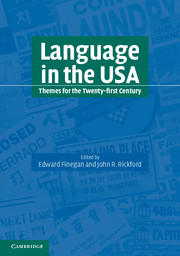Book contents
- Frontmatter
- Contents
- List of figures
- List of tables
- List of contributors
- Acknowledgments
- Foreword
- Editors' preface
- Part 1 American English
- Part 2 Other language varieties
- Part 3 The sociolinguistic situation
- 15 Language ideology and language prejudice
- 16 Ebonics and its controversy
- 17 Language planning, language policy, and the English-Only Movement
- 18 Language in education
- 19 Adolescent language
- 20 Slang
- 21 Hip Hop Nation Language
- 22 Language, gender, and sexuality
- 23 Linguistic identity and community in American literature
- 24 The language of doctors and patients
- 25 The language of cyberspace
- 26 Language attitudes to speech
- Index
24 - The language of doctors and patients
Published online by Cambridge University Press: 05 June 2012
- Frontmatter
- Contents
- List of figures
- List of tables
- List of contributors
- Acknowledgments
- Foreword
- Editors' preface
- Part 1 American English
- Part 2 Other language varieties
- Part 3 The sociolinguistic situation
- 15 Language ideology and language prejudice
- 16 Ebonics and its controversy
- 17 Language planning, language policy, and the English-Only Movement
- 18 Language in education
- 19 Adolescent language
- 20 Slang
- 21 Hip Hop Nation Language
- 22 Language, gender, and sexuality
- 23 Linguistic identity and community in American literature
- 24 The language of doctors and patients
- 25 The language of cyberspace
- 26 Language attitudes to speech
- Index
Summary
Editors' introduction
The late twentieth century witnessed a surge in interest in the professional language of law and medicine. Concern about the gap between expert language – in law, for example – and the abilities of clients to understand specialized “legal” language that could significantly impact their lives prompted legislation designed to ensure comprehensible consumer contracts such as insurance policies, automobile rental agreements, and apartment leases. Another enterprise in which language is critical to success is the interaction between doctors and patients, although it has not been the subject of legislation to the same degree. This chapter outlines three stages in the history of medical practice – from a time when neither doctors nor patients understood much about sickness to one in which scientific understanding and advanced diagnostic and therapeutic technologies have enhanced the practice of medicine but brought dissatisfaction and frustration to patients and some doctors over their medical encounters. Examining interaction in office visits, Cynthia Hagstrom exemplifies open-ended and closed-ended questions directed by doctors to their patients, and she suggests how different question types can affect replies and hinder or enhance the shared objectives of doctor and patient. You will see how the “voice of the life-world” and the “voice of medicine” can lead to misunderstanding and poorer medical outcomes.
The chapter also analyzes conversational asymmetry. Socially and culturally, as a consequence of physicians' technical knowledge and the institutional asymmetry of a patient seeking a doctor's expertise and guidance, doctors exercise greater power and control in interaction with patients.
- Type
- Chapter
- Information
- Language in the USAThemes for the Twenty-first Century, pp. 445 - 462Publisher: Cambridge University PressPrint publication year: 2004
- 1
- Cited by



